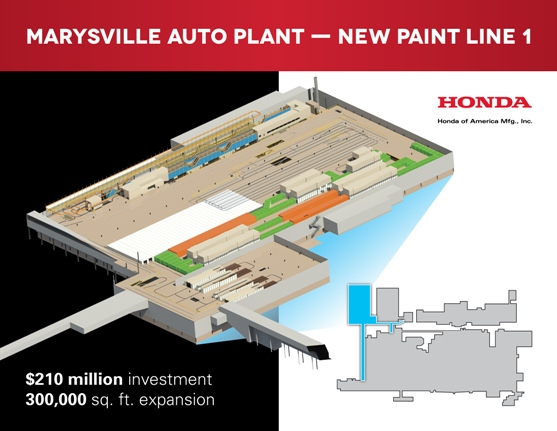Honda’s New $210 Million Vehicle Paint System Will Significantly Reduce Environmental Impacts
September 25, 2015 –

Honda of America Mfg., Inc. announced today a $210 million investment in a new, state-of-the-art paint line at its Marysville Auto Plant (MAP)—Honda’s first and largest auto plant in North America—to further its commitment to reducing its environmental footprint while improving on the already high quality of its products.
The new MAP Line 1 paint facility will utilize numerous new technologies to significantly reduce energy use, water use and chemical emissions from the vehicle painting process while at the same time, improving the quality of Honda and Acura vehicles produced at MAP using domestic and globally sourced parts. When complete, the new paint shop will be the most energy-efficient paint line in Honda’s U.S automobile production network. Auto body painting can account for upward of 60 percent of an automobile plant’s total energy use.
“Honda is committed to delivering products that have outstanding quality and low environmental impact,” said Tom Shoupe, executive vice president and COO of Honda of America Mfg., Inc. “With this new investment, our Ohio operations are once again raising the bar for quality and environmentally responsible manufacturing operations.”
Construction of the new paint line will begin this December and is slated for completion in December 2017. The new Line 1 paint shop will have a capacity of 229,000 units annually. The 300,000 square foot facility will replace the existing facility built in 1985. The Marysville plant’s Line 2 operation received a major renovation in 2006.
Short Process and New Primer Coat
The new paint shop will use a more compact and energy-efficient 4-coat, 2-bake short process – versus the 4-coat, 3-bake used on the current line, eliminating one primer-coat curing oven. To facilitate the new short process, the line will also use 2K waterborne primer designed exclusively for Honda in conjunction with its paint material supplier. The combination of the new 2k waterborne primer coat and waterborne base coat will reduce volatile organic compounds (VOC) emissions nearly 66 percent compared to existing Line 1 operations.
Dry-Booth Technology
The new paint line will use “dry-booth” technology, which uses limestone dust in place of water to capture paint overspray, reducing water use by two million gallons annually. Eliminating water used to capture paint particulates will eliminate paint sludge as a waste byproduct, resulting in the elimination of more than 255 tons of sludge. Additionally, the new booth will reduce CO2 emissions by 18 percent (12,000 metric tons annually). Based on Honda research, the new MAP Line 1 paint shop will be the highest-volume application of dry booth automobile painting technology in North America.
Two-Step Curing
The new paint shop will also advance vehicle appearance by using a new two-step temperature curing process with more automation, which supports paint finish appearance improvements.
Honda’s Environmental Commitment
Based on its vision of “Blue Skies for our Children,” Honda is working to advance technologies that address society’s environmental and energy concerns, resulting in a broad approach that addresses emissions, energy, water use, waste and other environmental impacts in all phases of its products’ life cycles. In the manufacturing realm, this includes a 97 percent reduction in waste sent to landfills in North America. Honda is also working to extend its “green factory” and “green purchasing” initiatives to its more than 650 parts suppliers in North America and is also pursuing more environmentally responsible business practices among its U.S. dealers.
Honda is advancing technologies that address environmental and energy concerns through a diverse lineup of products and technologies, including more fuel-efficient gasoline engines, hybrids, plug-in hybrids, battery electric vehicles (BEVs) and fuel-cell vehicles (FCEVs).
These activities reinforce Honda’s goal to voluntarily reduce its total corporate CO2 emissions by 50 percent by the year 2050, compared to 2000 levels. In 2006, Honda was the first auto company to voluntarily and publically commit to global reductions in its CO2 emissions. In pursuit of its vision for a lower-carbon future, the company is advancing electromotive technologies in many forms and will introduce an advanced new fuel cell car in 2016.
